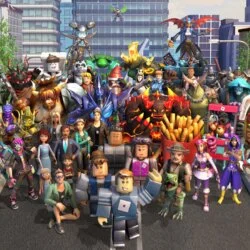Advertising a video game is about offering potential players an experience that goes beyond the gameplay itself. You have an opportunity to make people care about what you’ve made, so don’t waste it on simply telling them what they can do in your game. Use this opportunity to expand the world and extend the experience, because every asset you create becomes a part of the game’s context in the viewer’s mind.
So, where do many marketers go wrong?
When you’ve put so much work into adding thrills into every corner of your game, when it comes time to tell people about it, it’s understandable, that you may not know what to focus on first. In these brief moments of attention that you grab with your marketing, what do you want to draw attention to? Is it the customisation, the difficulty, the story, or the community?
According to the work of Harvard Professors Paul Lawrence and Nitin Nohria, there are four core human drives: the drive to acquire, to learn, to bond and to defend. If we are going to make any purchase today, it will be because it effectively taps into one, two, or maybe even three, of these core drives. However, most video games now tap into all four of these drives as part of the experience. They are most likely the features that help to hold players’ attention and make them feel motivated through the game, driving them towards the next goal. For example, video games give you opportunity to acquire new character skins or resources. They also give you the spaces, tools and challenges that allow you to learn and keep improving. Often games will accommodate communities you can join, or features that allow you to connect and bond with friends through the experience. You will even feel a strong desire to defend your base, your team or your top score. Trying to prioritise a list of features to tell the audience about your video game, results in no clear identifier for your game. It’s something we see a lot amongst our clients, from global brands to indie titles.
What to do instead
It’s important to recognise that what is actually on offer to gamers isn’t the ability to satisfy any one of these drives in particular, but to live a different life, in a new world, in which these motivations interact to form a web of desires that keep you moving through the experience. While they are the engine that keeps you on the path to progression, it’s the feeling that surrounds this journey that is the most enticing element.
Before introducing the drives within the game, we need to make the game world itself appealing. We need them to care about the world that’s been created. The best way of doing that is to make them feel as though they are already part of it.
This is why games built on already existing franchises are immediately popular. It’s why Supercell has leveraged familiar characters from its games to create new properties, and why Pokémon continues to sell millions of copies of its games nearly 30 years on.
But how do you compete with this if you are a new IP? As an agency marketing video games, this is the problem we’re often faced with, and here are some of the methods we use.
Establish an identity people can relate to
To create a clear identity that will appeal to players, you should drill down to the essence of your game, defining it in just one word or phrase. Amplifying a particular theme through your identity can create a clear value association for the audience, giving your game a deeper inherent worth in their minds.
Ask the question, ‘What is the story our players tell themselves about who they are, or who they want to be, that we can align with?’ Do your players value being the hero, do they value beauty, intelligence or moments of calm? The Goat Simulator series is a great example, representing the subversive and irreverent nature of its game through its advertising and unconventional naming strategy (the second game was called Goat Simulator 3).
Tell a short story that hooks them in
Stories involve the structuring of information. Your marketing is an opportunity to raise a question, planting information without a resolution and introducing a problem that needs to be solved. This can motivate audiences to discover and learn more through your game.
In addition to that, seeding a particular emotion through storytelling, that is representative of the in-game experience, inspires audiences to seek out more of that feeling by discovering your game. For instance, for Dead Island 2 we produced a 15-minute short story that brought to life the zombie apocalypse in LA, appealing to this genre’s target audience and not just illustrating the gameplay and context of the game, but also embodying its tone and personality. This gave people a way into the world and made them feel like they were part of the game before they’d played it.
Develop characters that they care about
The characters created in a game often have only fleeting moments to express themselves, either through dialogue boxes, short interactions or the occasional cutscene. With your marketing, you have an opportunity to build out the personalities and backstories of these characters to create a much deeper connection with your audience, so that when the player meets them in game, the impact of that interaction is even greater.
The characters on Boom Beach may appear tiny when you place them on an island, but every time I place a ‘Heavy’ on a landing beach, I see them in great detail in my mind’s eye thanks to the animations which have brought to life their movements, expressions, outfits and, most importantly, their personality. This builds a stronger attachment to the game and even more satisfaction as you witness them live out their role in-game.
Building long-lasting loyalty
Often these are component pieces that overlap but what they all have in common is they are intended to connect with who someone already is, to inform them who they will be when they enter this world.
If you’re able to connect with an audience by relating to their feelings of identity in this way, you’ve not just found a player, but you’ve founded the beginning of the kind of loyalty that you see with these long-established franchises. In short, games marketing isn’t just about telling players what they can do — it’s about showing them who they can become. By crafting a compelling world, telling meaningful stories and building characters that players care about, you’ll not only capture attention, but also build long-lasting loyalty. Remember, every asset is a chance to expand your game’s universe — use it wisely.
Featured image: Samsung Memory / Unsplash
































